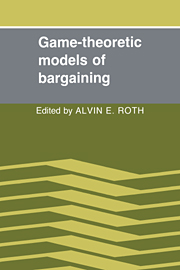Book contents
- Frontmatter
- Contents
- List of contributors
- Preface
- Chapter 1 Editor's introduction and overview
- Chapter 2 Disagreement in bargaining: Models with incomplete information
- Chapter 3 Reputations in games and markets
- Chapter 4 An approach to some noncooperative game situations with special attention to bargaining
- Chapter 5 Infinite-horizon models of bargaining with one-sided incomplete information
- Chapter 6 Choice of conjectures in a bargaining game with incomplete information
- Chapter 7 Analysis of two bargaining problems with incomplete information
- Chapter 8 Sequential bargaining mechanisms
- Chapter 9 The role of risk aversion in a simple bargaining model
- Chapter 10 Risk sensitivity and related properties for bargaining solutions
- Chapter 11 Axiomatic theory of bargaining with a variable population: A survey of recent results
- Chapter 12 Toward a focal-point theory of bargaining
- Chapter 13 Bargaining and coalitions
- Chapter 14 Axiomatic approaches to coalitional bargaining
- Chapter 15 A comment on the Coase theorem
- Chapter 16 Disclosure of evidence and resolution of disputes: Who should bear the burden of proof?
- Chapter 17 The role of arbitration and the theory of incentives
Chapter 4 - An approach to some noncooperative game situations with special attention to bargaining
Published online by Cambridge University Press: 23 September 2009
- Frontmatter
- Contents
- List of contributors
- Preface
- Chapter 1 Editor's introduction and overview
- Chapter 2 Disagreement in bargaining: Models with incomplete information
- Chapter 3 Reputations in games and markets
- Chapter 4 An approach to some noncooperative game situations with special attention to bargaining
- Chapter 5 Infinite-horizon models of bargaining with one-sided incomplete information
- Chapter 6 Choice of conjectures in a bargaining game with incomplete information
- Chapter 7 Analysis of two bargaining problems with incomplete information
- Chapter 8 Sequential bargaining mechanisms
- Chapter 9 The role of risk aversion in a simple bargaining model
- Chapter 10 Risk sensitivity and related properties for bargaining solutions
- Chapter 11 Axiomatic theory of bargaining with a variable population: A survey of recent results
- Chapter 12 Toward a focal-point theory of bargaining
- Chapter 13 Bargaining and coalitions
- Chapter 14 Axiomatic approaches to coalitional bargaining
- Chapter 15 A comment on the Coase theorem
- Chapter 16 Disclosure of evidence and resolution of disputes: Who should bear the burden of proof?
- Chapter 17 The role of arbitration and the theory of incentives
Summary
Introduction
In this paper, I consider an approach to modeling certain kinds of game situations that is somewhat different from the standard noncooperativegame approach. Roughly speaking, the situations have the following features in common: (1) a large number of players; (2) repeated partitioning of the player set over time into small, randomly selected groups; (3) gamelike interaction of the members of each group over a brief span of time; and (4) extensive knowledge by each player about the past history of actions taken by aggregates from the population, but limited information about the past history of actions taken by identifiable individuals in the populations. I have already applied this approach to an election model (Rosenthal (1982)) and, jointly with Henry Landau, to two bargaining models (Rosenthal and Landau (1979, 1981)). (In addition, Shefrin (1981) has worked on a related approach, with a view toward economic applications. An early version of this paper antedated and stimulated my work in this general area.) My goals in this chapter are to describe the approach (first spelled out in Rosenthal (1979)), its applicability, its advantages and disadvantages relative to alternative approaches, and also to discuss some side issues. In keeping with the spirit of this volume, however, I concentrate on the bargaining models.
Because the actions of individuals in the situations under consideration have little influence on the population aggregates, the approach assumes implicitly that individuals neglect this influence in making their decisions.
- Type
- Chapter
- Information
- Game-Theoretic Models of Bargaining , pp. 63 - 72Publisher: Cambridge University PressPrint publication year: 1985
- 1
- Cited by



